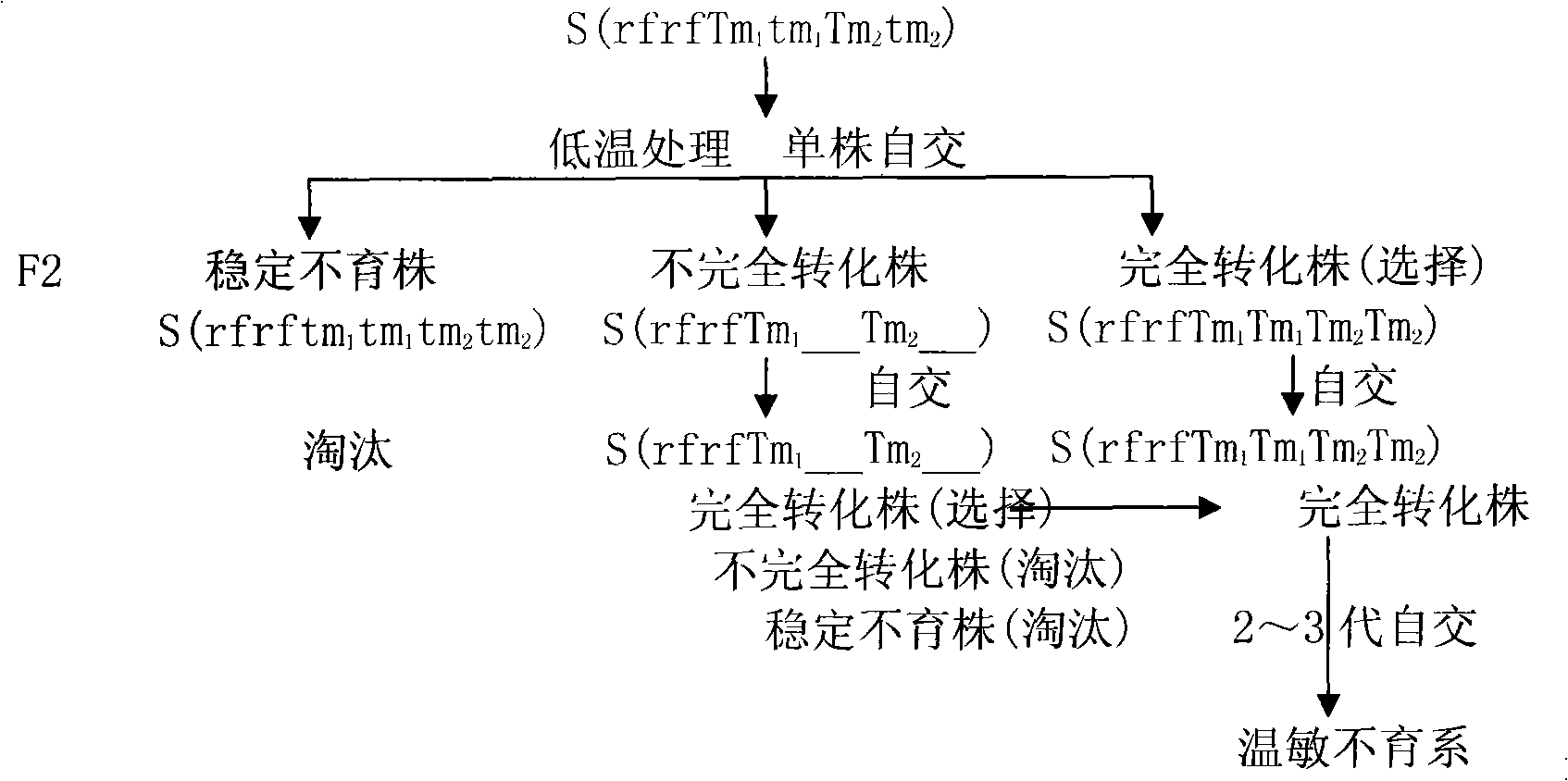Method for breeding celery cabbage temperature-sensitive male sterile line and temperature-insensitive male sterile line
A Chinese cabbage, male sterile line technology, applied in the directions of botanical equipment and methods, application, plant genetic improvement, etc., can solve the problems of low combining ability, difficulty in seed production, yellowing of leaves, etc., and achieves simplified utilization procedures. Effect
- Summary
- Abstract
- Description
- Claims
- Application Information
AI Technical Summary
Problems solved by technology
Method used
Image
Examples
Embodiment 1
[0020] 1) The temperature-sensitive male sterile line TsCMS7311 of Chinese cabbage bred by the School of Horticulture of Northwest A&F University was crossed with the Chinese cabbage Jinguan No. 1 bred by the School of Horticulture of Northwest A&F University, and the fertility was screened after 4°C low temperature treatment for 12 days at the bud stage Transform the first generation of hybrids, and in the fertile transformation period, select the fertility restorers to self-cross to obtain F 2 ;
[0021] 2) put F 2 After the seeds of the isolated generation germinated, they were vernalized at 4°C for 25 days, sown in a nutrient bowl, and grown under long-term light (3000 Lx for 14 hours) for 10 days, and then placed in the greenhouse for natural growth;
[0022] 3) After the vernalized seedlings have buds, the CMS materials are grouped according to the size of the buds, and then treated in a vernalization room at 4°C for 12 days;
[0023] 4) After the low temperature treat...
Embodiment 2
[0025] 1) The temperature-sensitive male sterile line TsCMS7311 of Chinese cabbage bred by the School of Horticulture of Northwest A&F University was crossed with the Chinese cabbage Jinguan No. 2 bred by the School of Horticulture of Northwest A&F University, and the fertility was screened after 7 days of low temperature treatment at 9°C during the bud stage. Transform the first generation of hybrids, and in the fertile transformation period, select the fertility restorers to self-cross to obtain F 2 ;
[0026] 2) put F 2 After the seeds of the isolated generation germinated, they were placed under the condition of 4°C for vernalization for 25 days, sowed in a nutrient pot, and placed in a long light (intensity of 3000Lx, time of 14 hours) for 8 days, and then placed in a greenhouse for natural growth;
[0027] 3) After the vernalized seedlings have buds, the CMS materials are grouped according to the size of the buds, and then treated in a vernalization room at 9°C for 7 da...
Embodiment 3
[0030] 1) The Chinese cabbage temperature-sensitive male sterile line TsCMS7311 selected by the School of Horticulture of Northwest A&F University will be crossed with the Chinese cabbage Jinguan No. 2 selected by the School of Horticulture of Northwest A&F University. After the bud stage is treated at 7°C for 10 days, the screening will be carried out. The first generation of hybrids with obvious fertility transformation, during the fertility transformation period, select the fertility restorer strains to self-cross to obtain F 2 ;
[0031] 2) put F 2 After germination of the seeds of the isolated generation, place them under the condition of 8°C for vernalization for 20 days, sow them in a nutrient bowl, and grow them under long-term light (3000 Lx for 14 hours) for 7 days, then put them in the greenhouse to grow naturally;
[0032] 3) After the vernalized seedlings have buds, the CMS materials are grouped according to the size of the buds, and then treated in a vernalizati...
PUM
 Login to View More
Login to View More Abstract
Description
Claims
Application Information
 Login to View More
Login to View More - R&D
- Intellectual Property
- Life Sciences
- Materials
- Tech Scout
- Unparalleled Data Quality
- Higher Quality Content
- 60% Fewer Hallucinations
Browse by: Latest US Patents, China's latest patents, Technical Efficacy Thesaurus, Application Domain, Technology Topic, Popular Technical Reports.
© 2025 PatSnap. All rights reserved.Legal|Privacy policy|Modern Slavery Act Transparency Statement|Sitemap|About US| Contact US: help@patsnap.com



